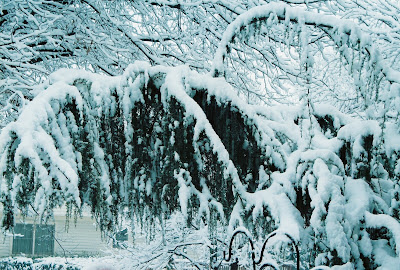If a scene wants to be be blue, then maybe we should let it be blue! Snowy landscapes tend to be blue on those dull, overcast winter days, and even when the sun is out, shaded areas have a bluish tinge. The color temperature on such days is probably in the 10,000K+ range — since there are no yellows and reds to temper the diffuse light, the ultra-violet (UV), violet and blue end of the spectrum predominate.
It may appear white to the human eye, since our brains compensate by ignoring the blue tinge. However, the lens transmits the light as it really is, and normal daylight film is very sensitive to UV radiation. UV radiation is recorded on film as blue and the dominant blue end of the spectrum present in overcast or shade situations further aggravates the situation, giving the overall scene a blue tinge.
Normally, to correct for the blue tinge, we use a Skylight 1A or UV filter for snowscapes and a warming filter such as a Tiffen 812 filter is usually recommended when photographing people to improve skin color. But what if we allowed the scene to be blue? Not only that, what if we actually enhanced the color by means of a blue filter? This past weekend, I had the chance – it snowed continuously all day Sunday, and I waited until we had a 2- 3 inch accumulation and then used the OM-2 with the Kiron 28-70mm fitted with a 80B filter.
The 80B filter is a color compensating filter to reduce the yellowish-red tinge when normal daylight film is used with tungsten lamps (studio use), but it can be used outdoors to create some spectacular blue effects, especially early morning (pre-dawn) landscapes and snow scenes. By way of contrast check out these photographs taken with the 81A warming filter.
Blue Snowscape #1
 |
Blue Snowscape #2
 |
Blue Snowscape #3
 |
Blue Snowscape #4
 |
Blue Snowscape #5
 |
Blue Snowscape #6
 |
Blue Snowscape #7
 |
Blue Snowscape #8
 |
Photographed with an OM-2 and Kiron 28-70mm f/3.5-4.5 lens fitted with an 80B filter, 1/125 sec at f/11 on Fuji Super HQ 200 ASA film.
Blue Snowscape #9
 |
Blue Snowscape #10
 |
I had previously experimented briefly with the 80B filter in Vail, CO last October. The day started out overcast, but it turned sunny, and I switched back to my Polarizer after a couple of shots. I used the Minolta Dynax 800si with a Maxxum AF 28-80mm f/4.5-5.6 lens and 80B filter, Fuji Super HQ 200 ASA film. These were taken early morning at the Sonnenalp Lodge in Vail Village.
text and images © 2007 ajoy muralidhar. all names, websites, brands and technical data referenced are the copyright or trademark of their respective owners.

















































You must be logged in to post a comment.